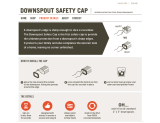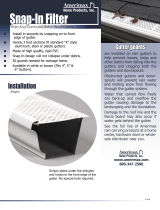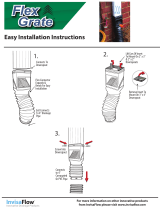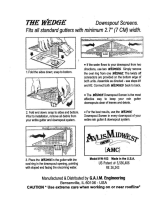Page is loading ...

Chromalox
®
DIVISION
4
SECTION
RG
SALES
REFERENCE
DATE
SERVICE REFERENCE
Installation, Operation
and
MAINTENANCE INSTRUCTIONS
PJ485-2
161-562406-001
MARCH, 2004
(Supersedes PF482)
(Supersedes PJ485-1)
© 2010 Chromalox, Inc.
INSPECTION
1. Open package and visually check for breaks or nicks in the
cable jacket. File claim with carrier if any damage is found.
2. Never energize the cable when it’s coiled or on a reel. Test
only when it is laid out straight.
3. After removing the cable from the carton or wrapping, check
the insulation resistance of the unit from buss wires to braid
with a 2500VDC megger to assure the cables have not been
damaged during shipping and handling.
ELECTRIC SHOCK HAZARD. Verify insulation resis-
tance is 20 megohms or greater before installing.
Contact Chromalox if cable is less than 20
megohm.
4. The heating cables should be stored in their shipping cartons
or on reels in a dry atmosphere until they are ready to be
installed.
General Instructions for Only Roof and Gutter
Snow and Ice Melting Applications for SRF-RG,
Thermwire
®
-Melt, Safe-T-Melt Cables
WARNING: These instructions are intended for cable being installed in ordinary non-hazardous areas. Using these
instructions, the braid is to be used as a grounding means and for physical protection only. DO NOT INSTALL
ROOF AND GUTTER PRODUCTS IN A HAZARDOUS AREA.

Table 2 — SRF-RG Table 3 — Thermwire Melt Table 4 — Safe-T-Melt
120V 120V 120V
15A 20A 30A 15A 20A 30A 10A 15A
Start Up @ 0°F 90 ft 120 ft 175 ft 90 ft 120 ft 175 ft 60 ft 100 ft
Start Up @ -20°F 75 ft 100 ft 150 ft 75 ft 100 ft 150 ft 60 ft 100 ft
240V 240V 240V Not Available
15A 20A 30A 15A 20A 30A
Start Up @ 0°F 135 ft 185 ft 275 ft 135 ft 185 ft 250 ft
Start Up @ -20°F 120 ft 160 ft 250 ft 120 ft 160 ft 250 ft
Maximum Allowable Circuit Lengths per Breaker Rating for 5W/Ft. Heating Cable
DESIGN
1. Walk the system to plan the layout of the heating cable.
2. Obtain the following roof information: roof edge length, roof
overhang, total gutter length, total downspout length and
breaker rating.
3. Calculate the amount of cable required.
A. Multiply the roof edge length by the spacing factor found
in Table 1.
B. Add the total gutter length plus the total downspout
length to the result obtained in Part A to determine the
total length of cable required.
4. Calculate the number of circuits required. Divide the total
length of cable required by the maximum heater length
allowed for the breaker rating. Tables 2, 3 and 4 indicate
maximum heater lengths depending upon the Chromalox
Roof and Gutter product selected.
5. Branch-Circuit Sizing: The ampacity of the branch circuit
conductor and the rating or setting of overcurrent devices
shall not be less than 125% of the ampere load of the cable
or units.
GENERAL
FIRE HAZARD. Do not use roof and gutter cable
for pipe freeze protection in or around mobile
homes. Do not exceed the maximum circuit length
described in these installation instructions.
Failure to comply could result in fire or personal
injury.
Before installation, make certain gutters and downspouts are free
of leaves and other debris.
Electrical connections must be MADE in accordance with nation-
al and local codes by a qualified person. (Ground fault protec-
tion is required. Verify with codes whether personnel protec-
tion, GFCI or equipment protection, EPD is required).
ELECTRIC SHOCK HAZARD. Disconnect all power
before installing or servicing heating cable and
accessories. A qualified person must perform
installation and service of heating cable and
accessories. Heating cable must be effectively
grounded in accordance with the National
Electrical Code. Failure to comply can result in
personal injury or property damage.
Table 1
AB
Roof Heating Heating Spacing
Overhang Width Height Factor
12” 2 ft 18” 2
24” 2 ft 30” 3
36” 2 ft 42” 4
Required Cable
A
B

INSTALLATION
1. The minimum installation temperature is -40°F (-40°C).
2. Locating the heating cable on the roof.
A. Loop the heating cable on the overhang area of the roof.
The overhang area is the portion of the roof which
extends beyond the building’s outside wall. The heating
cable loop should extend into the gutter to maintain a
drainage path. It should also extend to a point 6 inches
above the line where the wall joins the roof. The spacing
of the loops should be at 2 foot intervals. The minimum
bending radius is six times the minor diameter.
B. For flat roofs, the heating cable can be spaced as appro-
priate for creating drainage paths.
C. Secure the heating cable to the roof using Chromalox roof
clip kits for specified roof and gutter product. Chromalox
recommends using two clips to form the loop that extends
over the gutter edge and one clip to form the loop at the
top of the overhang. For flat roofs, secure the heating
cable to the roof with a clip at 3 foot intervals. See clip
instruction sheet for details.
D. It is recommended that a barrier (snow birds) or snow
fence be mounted on the roof above the heating cable.
This prevents damage to the heating cable system due to
ice slides. If desired, the heating cable can be attached to
the barrier with the Chromalox roof clips.
3. Locating the heating cable in gutters and downspouts.
A. Run the heating cable in and along the gutter. It is not neces-
sary to attach the heating cable to the gutter bottom.
B. When running the heating cable into, or out of the gutter,
use a Chromalox roof clip to prevent abrasion of the cable
C. In downspouts, the heating cable must extend below the
freezing level.
D. The heating cable can be looped in the downspout if it is
convenient to do so, such as when a downspout is not at the
end of a run. Note: Tee splices are not permitted and void
agency approvals.
E. Use a Chromalox downspout hanger to protect the heating
cable from damage caused by sharp gutter edges and to pro-
vide strain relief. See instruction sheet (PJ482) for details.
F. Protect any heating cable which protrudes past the lower
opening of the downspout.
4. Installing the installation accessories.
A. Install all end seals and splices prior to making power con-
nections.
B. Use only Chromalox Installation Accessories. Refer to the
appropriate product literature for the correct accessory cata-
log numbers for Power Connection Kit, Roof Clip Kit,
Splice Connection Kit and Downspout Hanger Kit.
C. If these kits are not used, or if their instructions are not fol-
lowed, then the installation will not comply with UL.
D. Use only UL Listed weather-proof junction boxes for power
connection.
5. Start-up requirements.
A. The power connection kit contains two caution labels that
must be visibly located. One must be at the circuit breaker
panel, the other on or next to the ON/OFF control for the
cable unit.
B. Prior to energizing the system, make sure the heating
cable is free of mechanical damage (nicks, cuts, etc.) and
thermal damage (solder, overheating, etc.). Visually
check all power connections, splices and end seals.
Perform 2500 VDC meggar check. The meggar check is
performed at the power connection end of the cable
between buss wire and the grounding braid. The mini-
mum acceptable reading is 20 megohms. If the installa-
tion fails the meggar test, check end seals, splice connec-
tions and cable sheath for physical damage or areas where
the grounding braid has come in contact with the buss
wires or conductive core. If physical damage can not be
found and end seals or splices are not the cause, then the
complete circuit should be removed and replaced with
new roof and gutter heating cable.
SERVICE
1. Prior to the winter season, make sure gutters and downspouts
are free of leaves and other debris.
2. Chromalox recommends checking the insulation resistance
of the heating cable sheath with a 2500 VDC meggar. This
reading is taken at the power connection end of the cable
between a buss wire and the grounding braid. The minimum
acceptable reading is 20 megohms. The value should be
recorded.
3. The installation should be checked every Fall. The following
checks should be done.
A. Meggar test (see #2 above for procedure).
B. Inspect heating cable and connections for signs of damage.
C. If physical damage is found, replace the damaged sections.
D. If the installation fails the meggar test and physical dam-
age cannot be found, then the complete circuit should be
removed and replaced with new roof and gutter heating
cable.
ELECTRIC SHOCK HAZARD. Disconnect all power
before installing or servicing heating cable and
accessories. A qualified person must perform
installation and service of heating cable and
accessories. Heating cable must be effectively
grounded in accordance with the National
Electrical Code. Failure to comply can result in
personal injury or property damage.
4. Prior to repairs performed on roof, heating cable must be
removed to prevent damage to cable. Cable must not be
exposed to chemical sealants that may be applied to roof sur-
face and must be stored away from area while sealants cure.
Upon replacement of cable, inspect for signs of physical
damage to cable and connections. Replace any damaged sec-
tions and connections.

1347 HEIL QUAKER BLVD., LAVERGNE, TN 37086
Phone: (615) 793-3900 www.chromalox.com
Limited Warranty:
Please refer to the Chromalox limited warranty applicable to this product at
http://www.chromalox.com/customer-service/policies/termsofsale.aspx.
/







